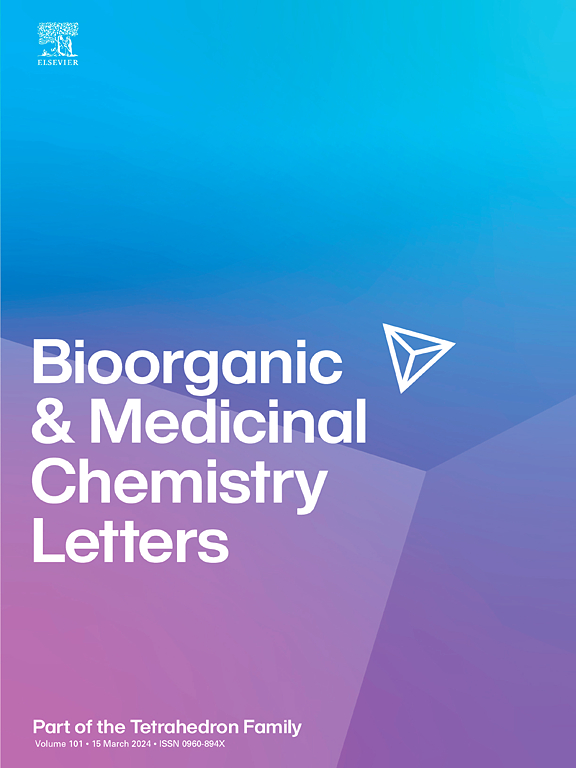Discovery of novel inhibitors for malate synthase of Mycobacterium Tuberculosis from natural products
IF 2.5
4区 医学
Q3 CHEMISTRY, MEDICINAL
引用次数: 0
Abstract
Tuberculosis (TB) caused by Mycobacterium tuberculosis (Mtb) remains a global public health threat, particularly due to dormant Mtb, which necessitates prolonged drug treatment. Mycobacterium tuberculosis malate synthase (MtbMS) is a key rate-limiting enzyme in the glyoxylate shunt, essential for the survival of dormant Mtb but absent in the host. Using target-based virtual screening and biochemical approaches, we identified novel natural inhibitors of MtbMS. Molecular docking by Schrödinger and subsequent manual selection identified 11 compounds as potential inhibitors. Molecular dynamics (MD) simulations and binding-free energy analysis (MM/GBSA) demonstrated high stability and binding affinity of MtbMS with Nordihydroguaiaretic Acids (NDGA) and Meso-NDGA. NDGA and Meso-NDGA by inhibition experiment exhibited half-maximal inhibitory concentrations (IC50) against MtbMS at 1.10 ± 0.01 μM and 14.29 ± 0.95 μM and by Isothermal Titration Calorimetry (ITC) showed binding constants (Kd) of 5.66 μM and 34.90 μM, respectively. Their minimum inhibitory concentrations (MIC) against Mtb H37Rv were 60.47 μg/mL and 30.24 μg/mL, respectively. In conclusion, natural products NDGA and Meso-NDGA are potent inhibitors of MtbMS and represent promising new scaffolds for combating dormant Mtb.

从天然产物中发现新的结核分枝杆菌苹果酸合成酶抑制剂。
由结核分枝杆菌(Mtb)引起的结核病(TB)仍然是一个全球性的公共卫生威胁,尤其是休眠的Mtb,需要长期的药物治疗。结核分枝杆菌苹果酸合成酶(MtbMS)是乙醛酸分流过程中的一个关键限速酶,对休眠 Mtb 的生存至关重要,但在宿主体内却不存在。利用基于靶点的虚拟筛选和生化方法,我们发现了新型的MtbMS天然抑制剂。通过薛定谔分子对接和随后的人工筛选,确定了 11 种化合物为潜在的抑制剂。分子动力学(MD)模拟和无结合能分析(MM/GBSA)证明了MtbMS与Nordihydroguaiaretic Acids(NDGA)和Meso-NDGA的高稳定性和结合亲和力。通过抑制实验,NDGA 和 Meso-NDGA 对 MtbMS 的半最大抑制浓度(IC50)分别为 1.10 ± 0.01 μM 和 14.29 ± 0.95 μM,通过等温滴定量热法(ITC)显示的结合常数(Kd)分别为 5.66 μM 和 34.90 μM。它们对 Mtb H37Rv 的最低抑制浓度(MIC)分别为 60.47 μg/mL 和 30.24 μg/mL。总之,天然产物NDGA和Meso-NDGA是MtbMS的强效抑制剂,是抗击休眠Mtb的有前途的新支架。
本文章由计算机程序翻译,如有差异,请以英文原文为准。
求助全文
约1分钟内获得全文
求助全文
来源期刊
CiteScore
5.70
自引率
3.70%
发文量
463
审稿时长
27 days
期刊介绍:
Bioorganic & Medicinal Chemistry Letters presents preliminary experimental or theoretical research results of outstanding significance and timeliness on all aspects of science at the interface of chemistry and biology and on major advances in drug design and development. The journal publishes articles in the form of communications reporting experimental or theoretical results of special interest, and strives to provide maximum dissemination to a large, international audience.

 求助内容:
求助内容: 应助结果提醒方式:
应助结果提醒方式:


